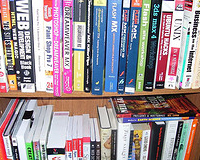 Anyone who writes about web design or runs a web design blog (like this one) is bound to get questions from new designers on a pretty regular basis. And most of us try to answer those questions as time allows (which, unfortunately, isn't as often as I'd like).
Since time can be an issue, I've pulled together some of the most common questions that get asked over and over again, and tried to answer them. These include things like where to learn to design, what skills you need, and how to get clients.
Now, I'm sure there are other questions out there that new designers have, and if you'll leave those in the comments, we'll try to do a part two and answer even more.
Anyone who writes about web design or runs a web design blog (like this one) is bound to get questions from new designers on a pretty regular basis. And most of us try to answer those questions as time allows (which, unfortunately, isn't as often as I'd like).
Since time can be an issue, I've pulled together some of the most common questions that get asked over and over again, and tried to answer them. These include things like where to learn to design, what skills you need, and how to get clients.
Now, I'm sure there are other questions out there that new designers have, and if you'll leave those in the comments, we'll try to do a part two and answer even more.
What skills do I need to learn to become a good designer?
A lot of people might be tempted to answer this with "design skills, duh!" But "design" isn't really a skill. It's a result. You need other skills to reach that result. So what are the skills that go into a good design? Here are the basics:- A sense of spatial relationships and proportions.
- A good grasp of color theory.
- The ability to take what's in your head and translate it to pixels.
- Project management
- Managing clients
- Basic bookkeeping
How and where should I start learning?
 I'm a firm believer in learning by doing. There are thousands of tutorials out there that can teach you everything you need to know about design, and then some. There is no single best source for learning how to design websites.
I'd propose a three-step process for learning how to design websites.
First, find some good reference sheets for HTML and CSS. There are dozens out there, so just find one that seems like it'll be easy to use.
Next, start in on some tutorials. Google is your friend here. Look for web design tutorials. The Tuts+ network is a good place to start, but they're not the only site out there that has high-quality tutorials. Follow a few of them from start to finish to get an idea of the whole process.
From there, start taking existing sites apart. Use tools like Firebug to see the code (HTML, CSS, and JavaScript). Figure out what makes them tick. Figure out which plugins and technologies they're using. Then rebuild the site from scratch, preferably without copying and pasting their code.
You could spend years reading books and articles that tell you how to build a website. But until you actually dive in and start creating, you're only going to get so far.
I'm a firm believer in learning by doing. There are thousands of tutorials out there that can teach you everything you need to know about design, and then some. There is no single best source for learning how to design websites.
I'd propose a three-step process for learning how to design websites.
First, find some good reference sheets for HTML and CSS. There are dozens out there, so just find one that seems like it'll be easy to use.
Next, start in on some tutorials. Google is your friend here. Look for web design tutorials. The Tuts+ network is a good place to start, but they're not the only site out there that has high-quality tutorials. Follow a few of them from start to finish to get an idea of the whole process.
From there, start taking existing sites apart. Use tools like Firebug to see the code (HTML, CSS, and JavaScript). Figure out what makes them tick. Figure out which plugins and technologies they're using. Then rebuild the site from scratch, preferably without copying and pasting their code.
You could spend years reading books and articles that tell you how to build a website. But until you actually dive in and start creating, you're only going to get so far.
Should I jump right into HTML5 and CSS3 or learn older versions first?
This is kind of a trick question. A lot of new designers don't realize that HTML5 and CSS3 include not only all the new technologies we keep hearing about, but also all of the applicable "old" technologies in the previous versions (minus those that have been deprecated). In other words, you should spend your time learning HTML5 and CSS3. If you learn HTML4 (or XHTML), you may be learning things you'll need to un-learn when you start in on HTML5. The same goes for CSS2 vs. CSS3. So just learn the newest/current technologies, plus any work-arounds you might need for older browsers.When should I learn a graphics program like Photoshop?
If you want to be a designer, you need to master some kind of graphics program. This could be Photoshop, Fireworks, Illustrator, GIMP, or any other program that does what you need it to. The thing is, even though you can technically design a site entirely in the browser, and with CSS3 you can even create some graphics without bothering with an image editing program, being proficient in this kind of program will be necessary at some point and will make your life easier more often than not. So in answer to when you should learn something like Photoshop, I say this: as soon as possible.Do I really need to learn to code?
There are designers out there who never touch code. Some of them do this by choice: they just don't like to code. But other times, it's because they never learned how to code. You really should know your way around basic front-end development. Even if you choose to outsource this or you work on a team where you only need to focus on the visual design, knowing the ins and outs of how code works will make your designs better. Knowing what's possible and what's not will also make you easier to work with from the perspective of developers. I would strongly recommend learning HTML5 and CSS3, at the very least, and familiarizing yourself with enough JavaScript so that you can use jQuery or another library without tearing your hair out. If you decide to learn additional programming languages beyond that, it'll only help you become a more versatile and well-rounded designer/developer.How long does it take to get your first client?
Sorry to use a cliché, but how long is a piece of string? Some designers are naturals. They can learn how to design well in a matter of a few weeks or a few months. It's often the technical aspects that hold them back in the beginning, rather than creative ones. Other designers take years to learn their craft before ever taking on paid client work. Either one is fine. If you feel ready to take on other people's projects after a couple months, then go for it. If it takes you years to reach that point, that's fine, too. A couple of bits of advice: first, make sure you have a few projects of your own completed before you start working for someone else. That means completed entirely, from creative brief to finished, live site. After that, you may want to consider designing a site for a friend or family member for free or at a deeply discounted price just to get used to working with a client before there's a significant amount of money (and your reputation) on the line. One last bit of advice: start small. As tempting as it might be, taking on a huge project early on can be a disaster. Until you've honed not only your design skills but also your project management skills, you're better off sticking with more manageable projects.Where can I find clients?
This is the question everyone asks. There's no one answer. You can start bidding on projects on sites like Elance.com. You can check Craigslist and other sites for local jobs. You can even call on local business owners to see if they're interested in a new or redesigned site. Let your friends and family know that you're open for business, and ask them for referrals to people they know who might be interested in your services. Write articles for design and business blogs that showcase your expertise. Be active on social media and make sure that your followers and friends know you're a web designer. Basically, put yourself out there as much as possible and go after new clients. Finally, make sure that your work is excellent. Your good work and good reputation are the best advertising you could ever hope to have.Read Next
15 Best New Fonts, July 2024
Welcome to our monthly roundup of the best fonts we’ve found online in the last four weeks. This month, there are fewer…
By Ben Moss
20 Best New Websites, July 2024
Welcome to July’s round up of websites to inspire you. This month’s collection ranges from the most stripped-back…
Top 7 WordPress Plugins for 2024: Enhance Your Site's Performance
WordPress is a hands-down favorite of website designers and developers. Renowned for its flexibility and ease of use,…
By WDD Staff
Exciting New Tools for Designers, July 2024
Welcome to this July’s collection of tools, gathered from around the web over the past month. We hope you’ll find…
3 Essential Design Trends, July 2024
Add some summer sizzle to your design projects with trendy website elements. Learn what's trending and how to use these…
15 Best New Fonts, June 2024
Welcome to our roundup of the best new fonts we’ve found online in the last month. This month, there are notably fewer…
By Ben Moss
20 Best New Websites, June 2024
Arranging content in an easily accessible way is the backbone of any user-friendly website. A good website will present…
Exciting New Tools for Designers, June 2024
In this month’s roundup of the best tools for web designers and developers, we’ll explore a range of new and noteworthy…
3 Essential Design Trends, June 2024
Summer is off to a fun start with some highly dramatic website design trends showing up in projects. Let's dive in!
15 Best New Fonts, May 2024
In this month’s edition, there are lots of historically-inspired typefaces, more of the growing trend for French…
By Ben Moss
How to Reduce The Carbon Footprint of Your Website
On average, a web page produces 4.61 grams of CO2 for every page view; for whole sites, that amounts to hundreds of KG…
By Simon Sterne
20 Best New Websites, May 2024
Welcome to May’s compilation of the best sites on the web. This month we’re focused on color for younger humans,…














